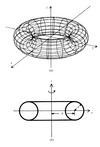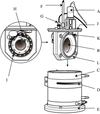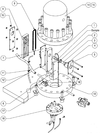issue contents
October 2001 issue

Cover illustration: Diffuse scattering around a 200 Bragg peak from a Cu-Ti single crystal (the intensities are in ln scale, the plane is (001), with the [100] direction horizontal, and the Bragg peak is masked by the blue beam stop). Courtesy of O. Lyon, C. Servant & J. P. Simon [J. Appl. Cryst. (2000), 33, 928-937].
research papers
The evolution of the microstructure of Re-rich Ni-base superalloy at high temperatures was investigated in situ by small-angle neutron scattering. Parameters calculated from the scattering curves enable one to determine the optimum temperature for homogenizing heat treatment.
The two major constituents of carbo-nitrided steel layers, i.e. the martensite and the austenite, and the incoherent scattering fraction are analysed by X-ray diffraction, defining the volume fraction of retained austenite. A micro-mechanical model is then developed to evaluate the true stress and carbon content of both phases.
A formula for estimating the statistical uncertainty of peak positions, determined by individual profile fitting, has been derived. The formula explicitly states which factors are important to improve precision: (i) good counting statistics, (ii) sharp peak profile, (iii) Gaussian profile shape when the parameter for profile asymmetry is not refined, (iv) symmetric profile shape, (v) high peak-to-background ratio, and (vi) perfect profile modelling.
In iron–nickel meteorite samples, diffraction contrast from kamacite lamellae was observed in conventional X-ray transmission radiographs oriented parallel to one or two of the lamellae habit planes.
Diffraction with high-energy X-rays is used to determine the alignment of kaolinite particles flowing as a dispersion in a pipe. The principles of the method are described and the important effect of the walls on alignment is noted.
The radii of gyration and scattering functions of a torus and its derivatives have been derived in cylindrical coordinates.
The current methods in the field of diffractive residual-stress analysis are briefly described and specific difficulties, including the quality of the experimental data and the applied micro-mechanical models (especially when texture cannot be neglected), are discussed. The key relations for the BPGeo micro-mechanical model (in which a texture-weighted geometric mean is applied in the stress analysis) are given for the general case and the possibility of resolving the so-called d0 problem using the original line-position data for a structure refinement is demonstrated.
A new three-dimensional crystal characterization technique, based on the combination of X-ray diffraction topography and computed microtomography, is discussed and first experimental results are presented for the case of a synthetic diamond single crystal.
A new design of monochromator for high-resolution X-ray diffraction, based on a single crystal, is described. While its resolution and beam intensity compare well with those of the Bartels monochromator, its compact design and easy alignment offer additional advantages.
A Monte Carlo code for the simulation of strain scanning experiments is presented. Simulated instrumental resolution, beam divergence and wavelength distribution are in good agreement with experimental results.
In stroboscopic section topography studies of the propagation modes of ultra-acoustic waves in quartz planar resonators, the images present a number of internal lines inside the section that allow a quantitative analysis of the vibration modes. When the excitation level increases, the shape of the lines enables the study of the dumping of the vibration along the surface of the device.
The reverse Monte Carlo method, applied to the study of crystalline materials, is developed further by fitting the Bragg peak intensities explicitly.
Two-dimensional spin echo small-angle neutron scattering experiments are proposed for the direct measurement of the vector-length distribution function. Interpretation of the correlation function from one-dimensional experiments is also presented.
Asymmetric Laue crystals were used in a double-crystal monochromator to focus high-energy X-rays sagittally. Adjustments of the tilt angle and height of the bent crystal resulted in first- and second-order corrections, respectively, to the dependence of the diffraction angle on the sagittal position.
A furnace is described for in situ X-ray diffraction studies, in transmission mode, of structural changes in electrode materials for Li-ion (polymer) batteries in the ambient to 300°C temperature range.
teaching and education
Free 

Simulations of electron density maps and the determination of the influence of thermal vibration on these maps using the program Mathematica are described.
short communications
Based on atomic force microscopy observations, a check-like twin structure in the self-frequency-doubling laser crystal material Yb:YAl3(BO3)4 is found.
It is shown how micro X-ray diffraction supported by a two-dimensional detector is an easy and rapid method for overcoming preferred orientation of powder samples.
The microstructure of a partially crystallized Zr-based bulk amorphous alloy is analyzed by means of small-angle neutron scattering and high-resolution electron microscopy. Mean diameter, size distribution and packing fraction of the crystallites are estimated.
computer programs
A computer program is elaborated for the determination of crystallite size distribution and dislocation structure by fitting the measured diffraction profiles by ab initio theoretical functions.
laboratory notes
The design of a furnace covering the range from 25 to 1000°C for in situ X-ray diffraction studies in transmission geometry is presented.


 journal menu
journal menu






































